2006 TOYOTA RAV4 harness
[x] Cancel search: harnessPage 186 of 2000
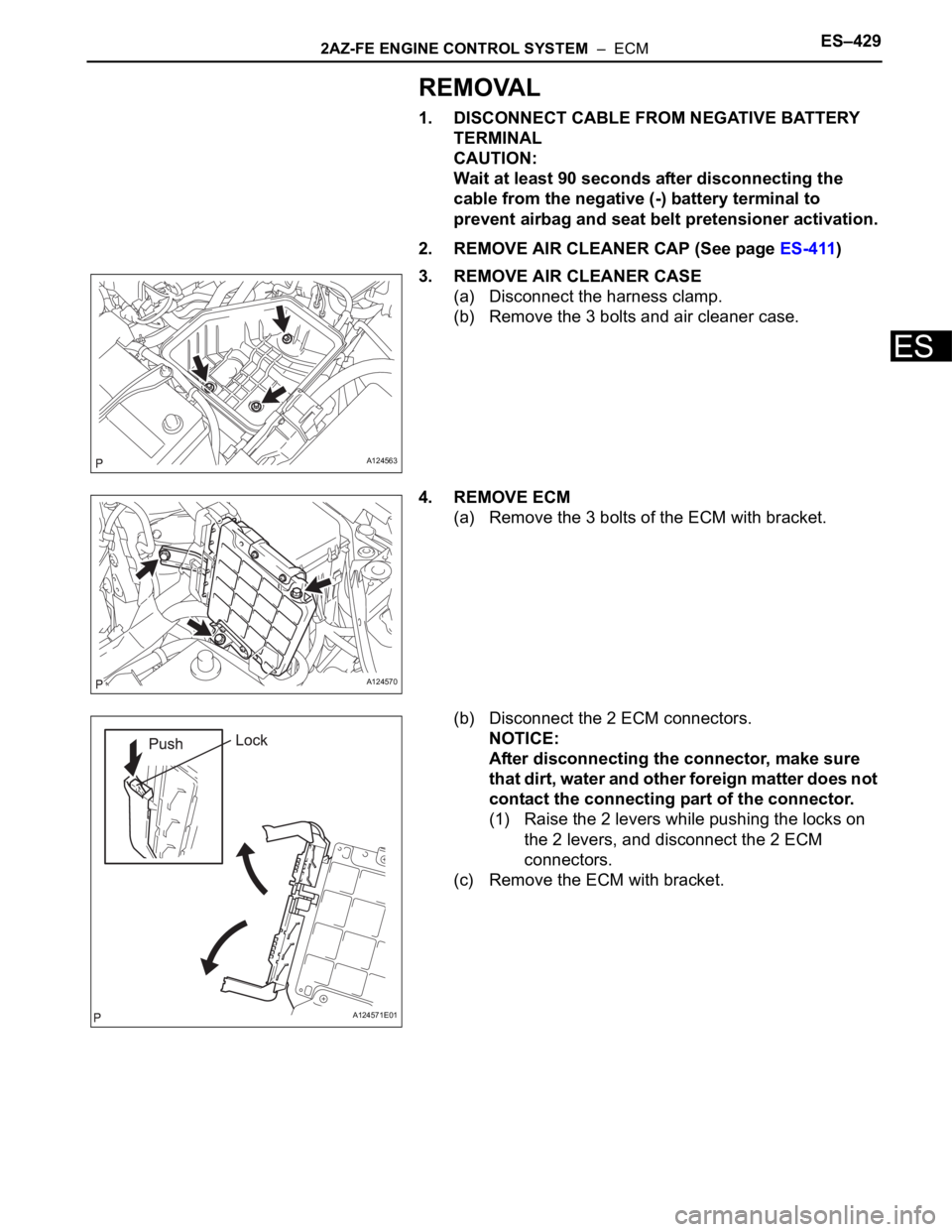
2AZ-FE ENGINE CONTROL SYSTEM – ECMES–429
ES
REMOVAL
1. DISCONNECT CABLE FROM NEGATIVE BATTERY
TERMINAL
CAUTION:
Wait at least 90 seconds after disconnecting the
cable from the negative (-) battery terminal to
prevent airbag and seat belt pretensioner activation.
2. REMOVE AIR CLEANER CAP (See page ES-411)
3. REMOVE AIR CLEANER CASE
(a) Disconnect the harness clamp.
(b) Remove the 3 bolts and air cleaner case.
4. REMOVE ECM
(a) Remove the 3 bolts of the ECM with bracket.
(b) Disconnect the 2 ECM connectors.
NOTICE:
After disconnecting the connector, make sure
that dirt, water and other foreign matter does not
contact the connecting part of the connector.
(1) Raise the 2 levers while pushing the locks on
the 2 levers, and disconnect the 2 ECM
connectors.
(c) Remove the ECM with bracket.
A124563
A124570
A124571E01
Page 188 of 2000
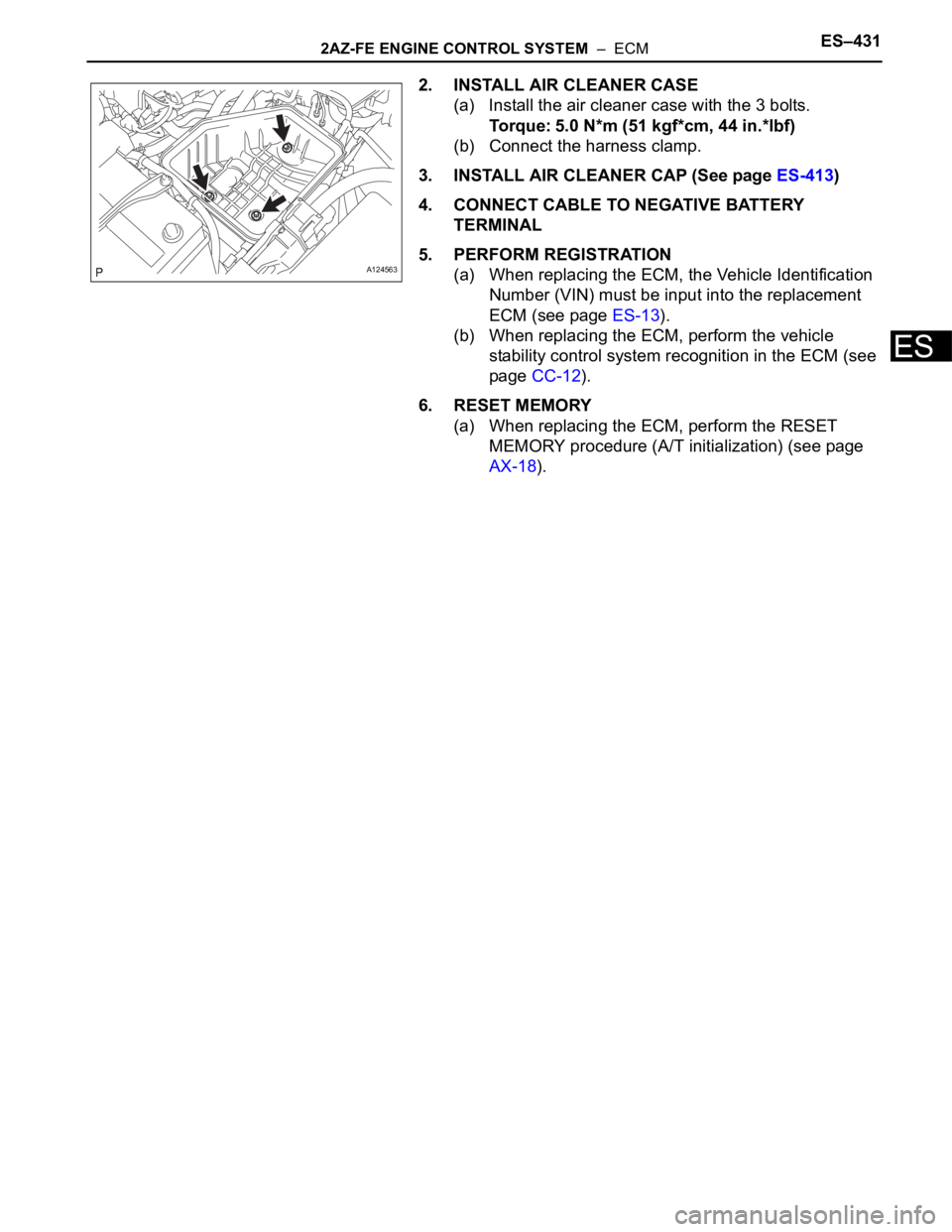
2AZ-FE ENGINE CONTROL SYSTEM – ECMES–431
ES
2. INSTALL AIR CLEANER CASE
(a) Install the air cleaner case with the 3 bolts.
Torque: 5.0 N*m (51 kgf*cm, 44 in.*lbf)
(b) Connect the harness clamp.
3. INSTALL AIR CLEANER CAP (See page ES-413)
4. CONNECT CABLE TO NEGATIVE BATTERY
TERMINAL
5. PERFORM REGISTRATION
(a) When replacing the ECM, the Vehicle Identification
Number (VIN) must be input into the replacement
ECM (see page ES-13).
(b) When replacing the ECM, perform the vehicle
stability control system recognition in the ECM (see
page CC-12).
6. RESET MEMORY
(a) When replacing the ECM, perform the RESET
MEMORY procedure (A/T initialization) (see page
AX-18).
A124563
Page 197 of 2000
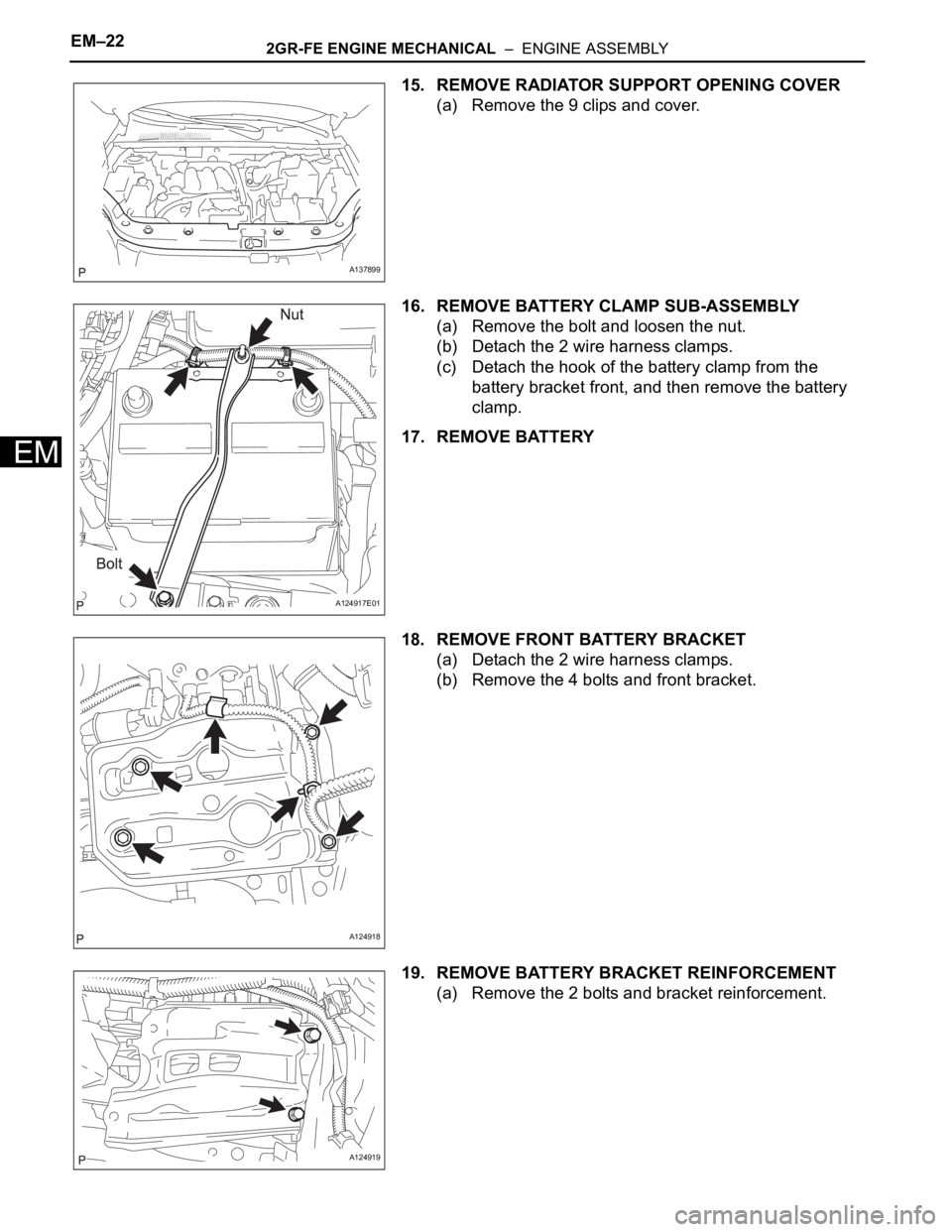
EM–222GR-FE ENGINE MECHANICAL – ENGINE ASSEMBLY
EM
15. REMOVE RADIATOR SUPPORT OPENING COVER
(a) Remove the 9 clips and cover.
16. REMOVE BATTERY CLAMP SUB-ASSEMBLY
(a) Remove the bolt and loosen the nut.
(b) Detach the 2 wire harness clamps.
(c) Detach the hook of the battery clamp from the
battery bracket front, and then remove the battery
clamp.
17. REMOVE BATTERY
18. REMOVE FRONT BATTERY BRACKET
(a) Detach the 2 wire harness clamps.
(b) Remove the 4 bolts and front bracket.
19. REMOVE BATTERY BRACKET REINFORCEMENT
(a) Remove the 2 bolts and bracket reinforcement.
A137899
A124917E01
A124918
A124919
Page 198 of 2000
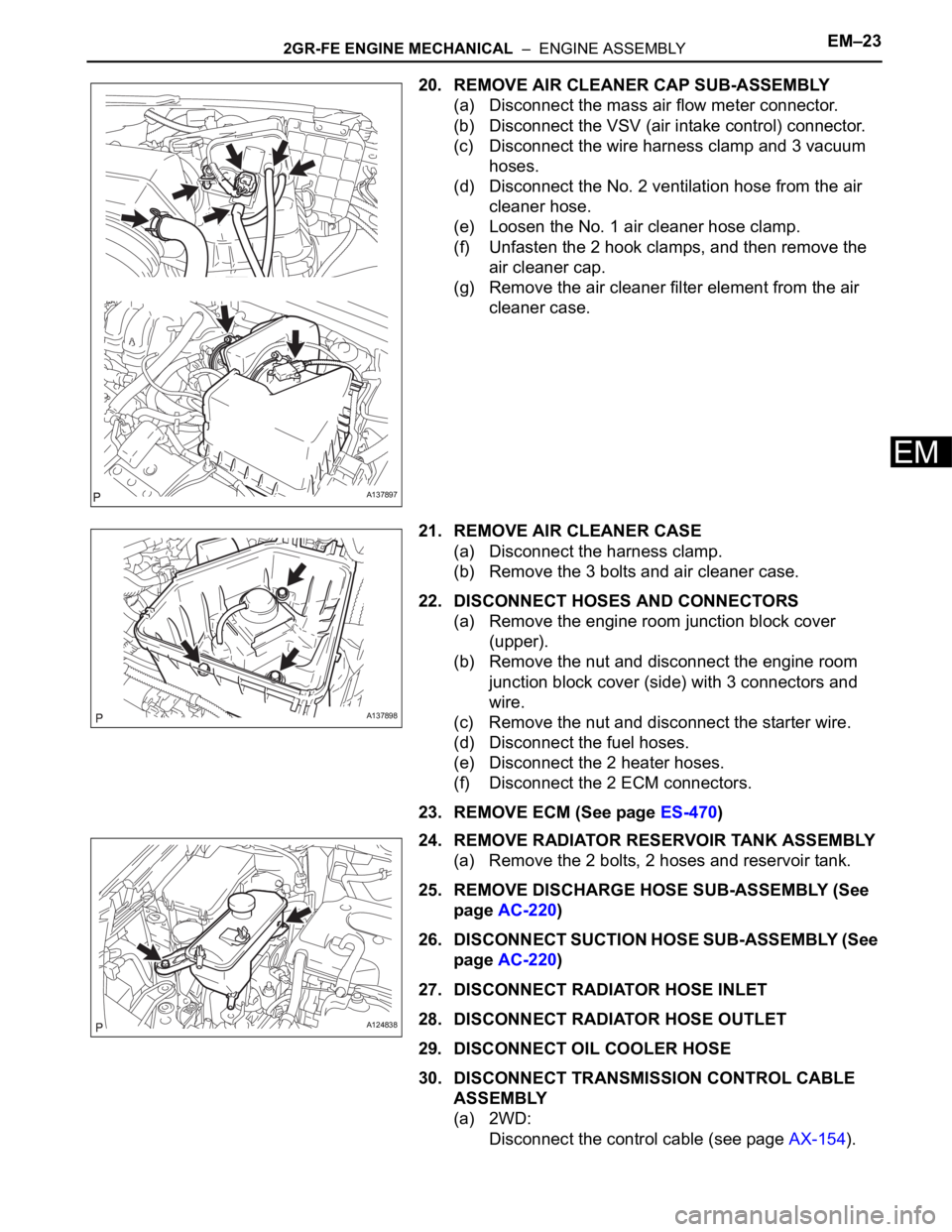
2GR-FE ENGINE MECHANICAL – ENGINE ASSEMBLYEM–23
EM
20. REMOVE AIR CLEANER CAP SUB-ASSEMBLY
(a) Disconnect the mass air flow meter connector.
(b) Disconnect the VSV (air intake control) connector.
(c) Disconnect the wire harness clamp and 3 vacuum
hoses.
(d) Disconnect the No. 2 ventilation hose from the air
cleaner hose.
(e) Loosen the No. 1 air cleaner hose clamp.
(f) Unfasten the 2 hook clamps, and then remove the
air cleaner cap.
(g) Remove the air cleaner filter element from the air
cleaner case.
21. REMOVE AIR CLEANER CASE
(a) Disconnect the harness clamp.
(b) Remove the 3 bolts and air cleaner case.
22. DISCONNECT HOSES AND CONNECTORS
(a) Remove the engine room junction block cover
(upper).
(b) Remove the nut and disconnect the engine room
junction block cover (side) with 3 connectors and
wire.
(c) Remove the nut and disconnect the starter wire.
(d) Disconnect the fuel hoses.
(e) Disconnect the 2 heater hoses.
(f) Disconnect the 2 ECM connectors.
23. REMOVE ECM (See page ES-470)
24. REMOVE RADIATOR RESERVOIR TANK ASSEMBLY
(a) Remove the 2 bolts, 2 hoses and reservoir tank.
25. REMOVE DISCHARGE HOSE SUB-ASSEMBLY (See
page AC-220)
26. DISCONNECT SUCTION HOSE SUB-ASSEMBLY (See
page AC-220)
27. DISCONNECT RADIATOR HOSE INLET
28. DISCONNECT RADIATOR HOSE OUTLET
29. DISCONNECT OIL COOLER HOSE
30. DISCONNECT TRANSMISSION CONTROL CABLE
ASSEMBLY
(a) 2WD:
Disconnect the control cable (see page AX-154).
A137897
A137898
A124838
Page 215 of 2000
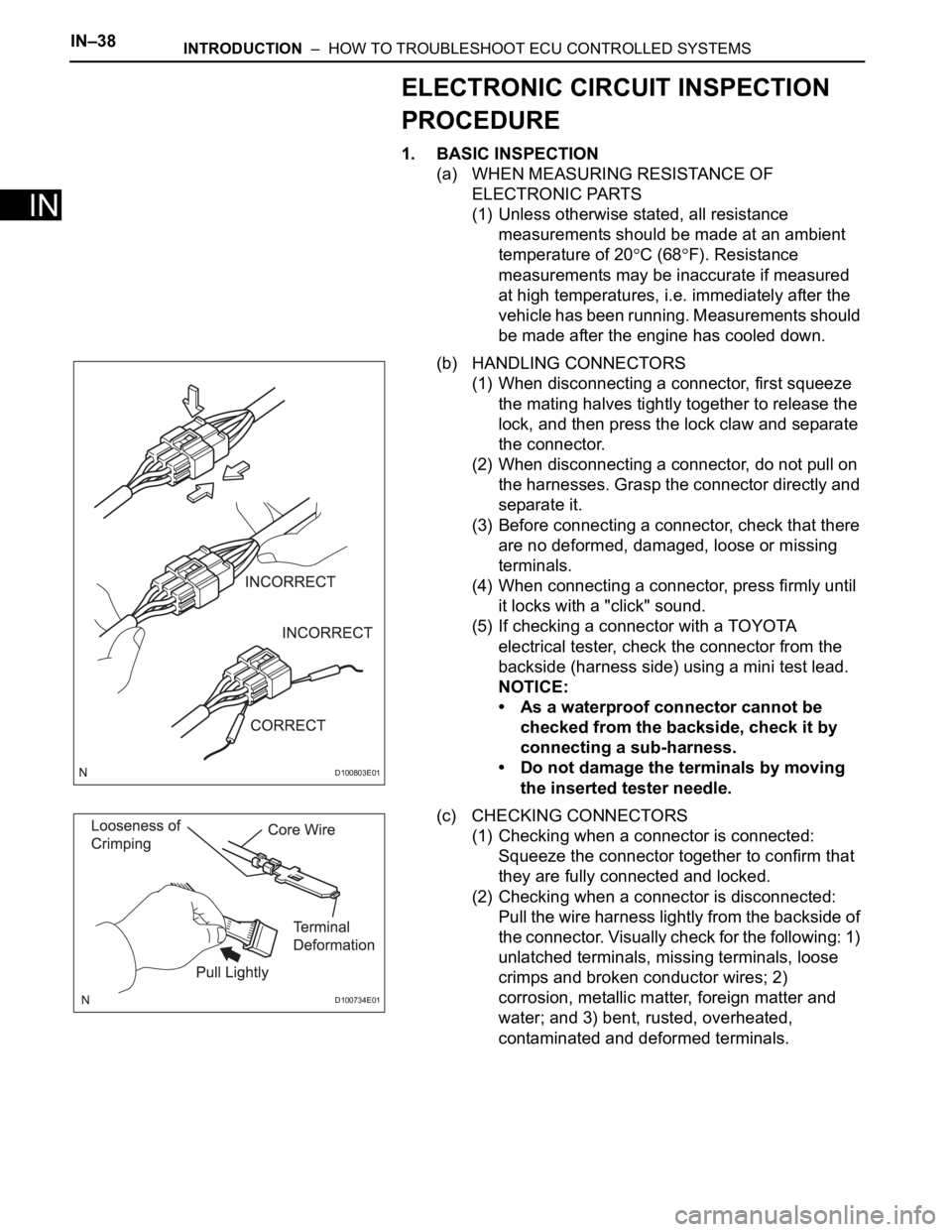
IN–38INTRODUCTION – HOW TO TROUBLESHOOT ECU CONTROLLED SYSTEMS
IN
ELECTRONIC CIRCUIT INSPECTION
PROCEDURE
1. BASIC INSPECTION
(a) WHEN MEASURING RESISTANCE OF
ELECTRONIC PARTS
(1) Unless otherwise stated, all resistance
measurements should be made at an ambient
temperature of 20
C (68F). Resistance
measurements may be inaccurate if measured
at high temperatures, i.e. immediately after the
vehicle has been running. Measurements should
be made after the engine has cooled down.
(b) HANDLING CONNECTORS
(1) When disconnecting a connector, first squeeze
the mating halves tightly together to release the
lock, and then press the lock claw and separate
the connector.
(2) When disconnecting a connector, do not pull on
the harnesses. Grasp the connector directly and
separate it.
(3) Before connecting a connector, check that there
are no deformed, damaged, loose or missing
terminals.
(4) When connecting a connector, press firmly until
it locks with a "click" sound.
(5) If checking a connector with a TOYOTA
electrical tester, check the connector from the
backside (harness side) using a mini test lead.
NOTICE:
• As a waterproof connector cannot be
checked from the backside, check it by
connecting a sub-harness.
• Do not damage the terminals by moving
the inserted tester needle.
(c) CHECKING CONNECTORS
(1) Checking when a connector is connected:
Squeeze the connector together to confirm that
they are fully connected and locked.
(2) Checking when a connector is disconnected:
Pull the wire harness lightly from the backside of
the connector. Visually check for the following: 1)
unlatched terminals, missing terminals, loose
crimps and broken conductor wires; 2)
corrosion, metallic matter, foreign matter and
water; and 3) bent, rusted, overheated,
contaminated and deformed terminals.
D100803E01
D100734E01
Page 216 of 2000
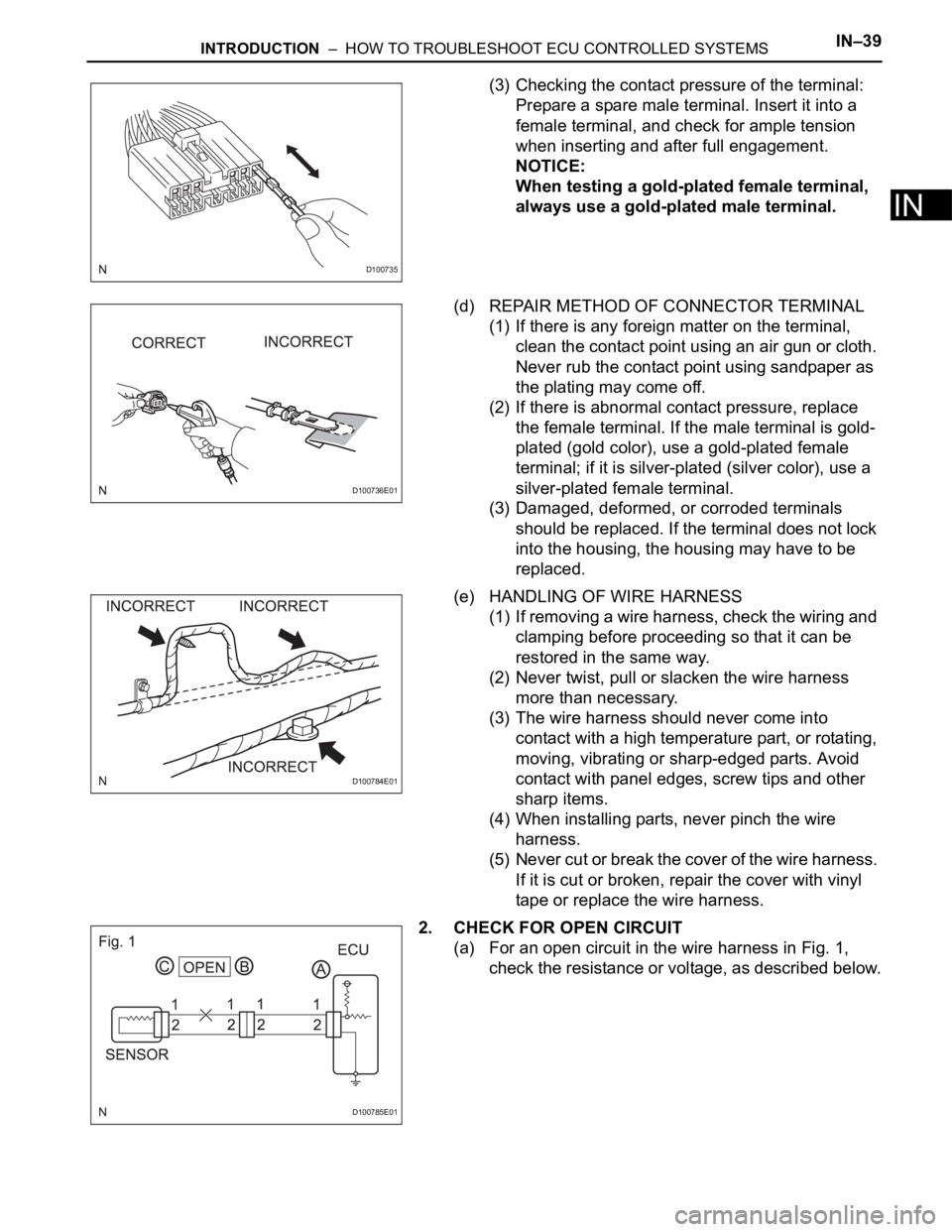
INTRODUCTION – HOW TO TROUBLESHOOT ECU CONTROLLED SYSTEMSIN–39
IN
(3) Checking the contact pressure of the terminal:
Prepare a spare male terminal. Insert it into a
female terminal, and check for ample tension
when inserting and after full engagement.
NOTICE:
When testing a gold-plated female terminal,
always use a gold-plated male terminal.
(d) REPAIR METHOD OF CONNECTOR TERMINAL
(1) If there is any foreign matter on the terminal,
clean the contact point using an air gun or cloth.
Never rub the contact point using sandpaper as
the plating may come off.
(2) If there is abnormal contact pressure, replace
the female terminal. If the male terminal is gold-
plated (gold color), use a gold-plated female
terminal; if it is silver-plated (silver color), use a
silver-plated female terminal.
(3) Damaged, deformed, or corroded terminals
should be replaced. If the terminal does not lock
into the housing, the housing may have to be
replaced.
(e) HANDLING OF WIRE HARNESS
(1) If removing a wire harness, check the wiring and
clamping before proceeding so that it can be
restored in the same way.
(2) Never twist, pull or slacken the wire harness
more than necessary.
(3) The wire harness should never come into
contact with a high temperature part, or rotating,
moving, vibrating or sharp-edged parts. Avoid
contact with panel edges, screw tips and other
sharp items.
(4) When installing parts, never pinch the wire
harness.
(5) Ne ver c ut or break th e c ov er of t he w ir e har ness .
If it is cut or broken, repair the cover with vinyl
tape or replace the wire harness.
2. CHECK FOR OPEN CIRCUIT
(a) For an open circuit in the wire harness in Fig. 1,
check the resistance or voltage, as described below.
D100735
D100736E01
D100784E01
D100785E01
Page 217 of 2000
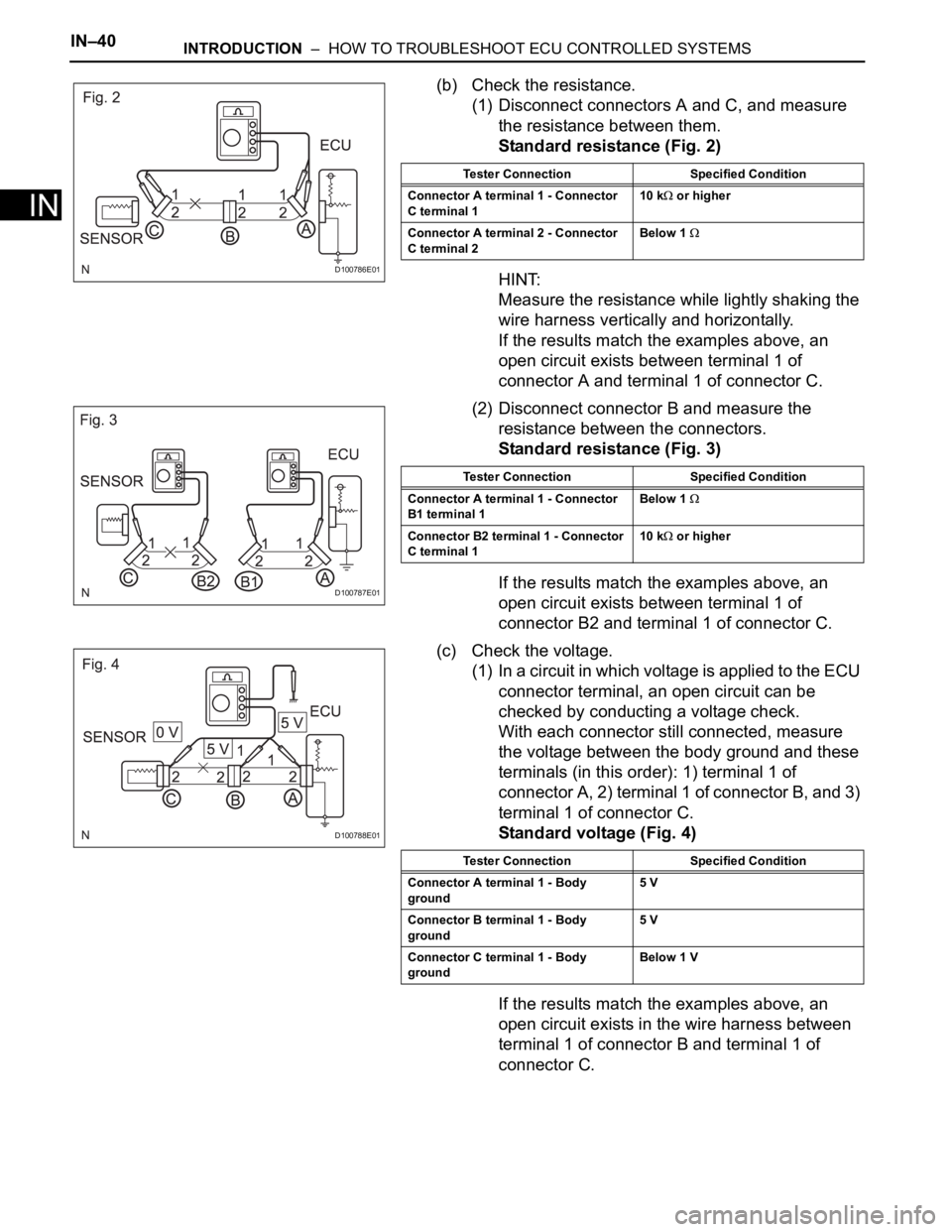
IN–40INTRODUCTION – HOW TO TROUBLESHOOT ECU CONTROLLED SYSTEMS
IN
(b) Check the resistance.
(1) Disconnect connectors A and C, and measure
the resistance between them.
Standard resistance (Fig. 2)
HINT:
Measure the resistance while lightly shaking the
wire harness vertically and horizontally.
If the results match the examples above, an
open circuit exists between terminal 1 of
connector A and terminal 1 of connector C.
(2) Disconnect connector B and measure the
resistance between the connectors.
Standard resistance (Fig. 3)
If the results match the examples above, an
open circuit exists between terminal 1 of
connector B2 and terminal 1 of connector C.
(c) Check the voltage.
(1) In a circuit in which voltage is applied to the ECU
connector terminal, an open circuit can be
checked by conducting a voltage check.
With each connector still connected, measure
the voltage between the body ground and these
terminals (in this order): 1) terminal 1 of
connector A, 2) terminal 1 of connector B, and 3)
terminal 1 of connector C.
Standard voltage (Fig. 4)
If the results match the examples above, an
open circuit exists in the wire harness between
terminal 1 of connector B and terminal 1 of
connector C.
D100786E01
Tester Connection Specified Condition
Connector A terminal 1 - Connector
C terminal 110 k
or higher
Connector A terminal 2 - Connector
C terminal 2Below 1
D100787E01
Tester Connection Specified Condition
Connector A terminal 1 - Connector
B1 terminal 1Below 1
Connector B2 terminal 1 - Connector
C terminal 110 k or higher
D100788E01
Tester Connection Specified Condition
Connector A terminal 1 - Body
ground5 V
Connector B terminal 1 - Body
ground5 V
Connector C terminal 1 - Body
groundBelow 1 V
Page 218 of 2000
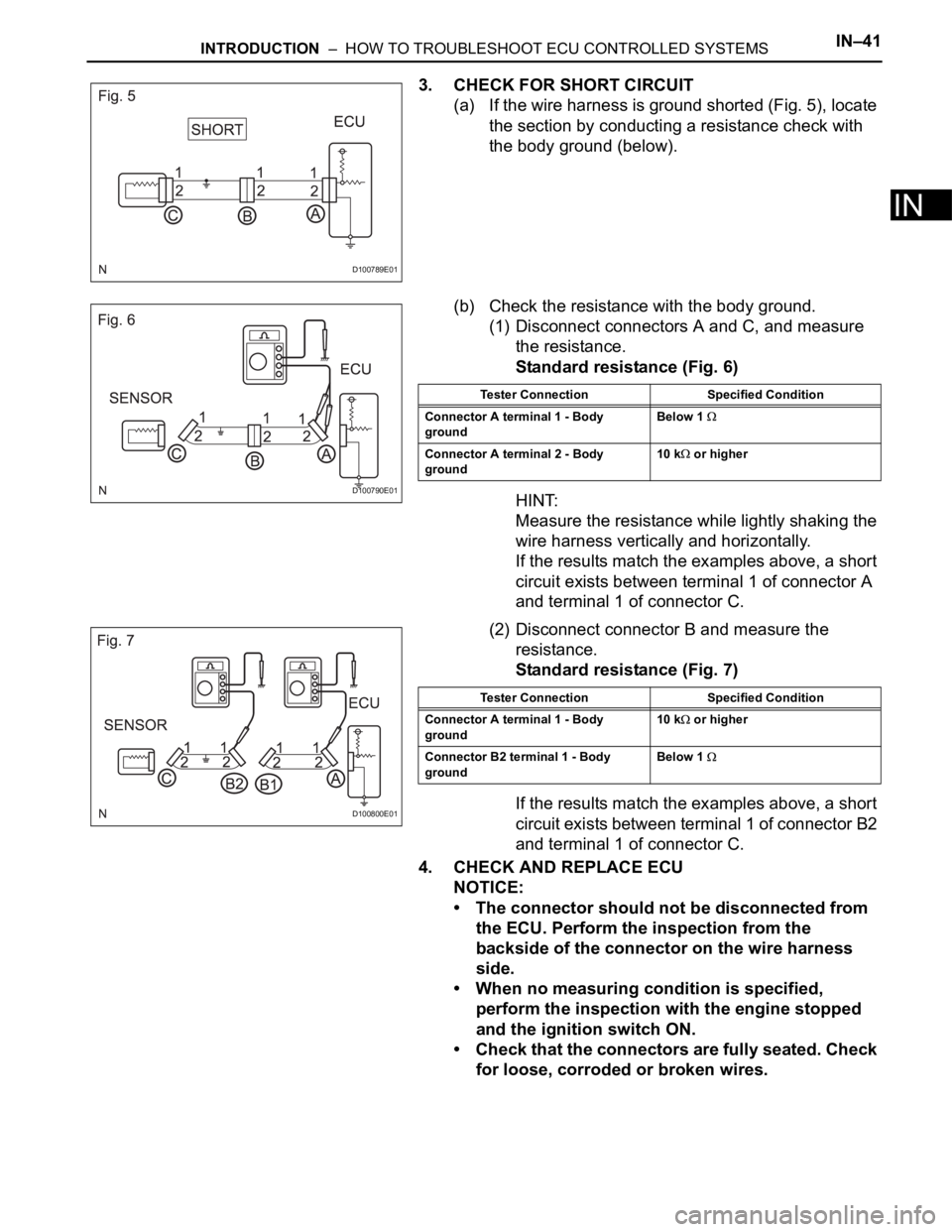
INTRODUCTION – HOW TO TROUBLESHOOT ECU CONTROLLED SYSTEMSIN–41
IN
3. CHECK FOR SHORT CIRCUIT
(a) If the wire harness is ground shorted (Fig. 5), locate
the section by conducting a resistance check with
the body ground (below).
(b) Check the resistance with the body ground.
(1) Disconnect connectors A and C, and measure
the resistance.
Standard resistance (Fig. 6)
HINT:
Measure the resistance while lightly shaking the
wire harness vertically and horizontally.
If the results match the examples above, a short
circuit exists between terminal 1 of connector A
and terminal 1 of connector C.
(2) Disconnect connector B and measure the
resistance.
Standard resistance (Fig. 7)
If the results match the examples above, a short
circuit exists between terminal 1 of connector B2
and terminal 1 of connector C.
4. CHECK AND REPLACE ECU
NOTICE:
• The connector should not be disconnected from
the ECU. Perform the inspection from the
backside of the connector on the wire harness
side.
• When no measuring condition is specified,
perform the inspection with the engine stopped
and the ignition switch ON.
• Check that the connectors are fully seated. Check
for loose, corroded or broken wires.
D100789E01
D100790E01
Tester Connection Specified Condition
Connector A terminal 1 - Body
groundBelow 1
Connector A terminal 2 - Body
ground10 k or higher
D100800E01
Tester Connection Specified Condition
Connector A terminal 1 - Body
ground10 k
or higher
Connector B2 terminal 1 - Body
ground Below 1